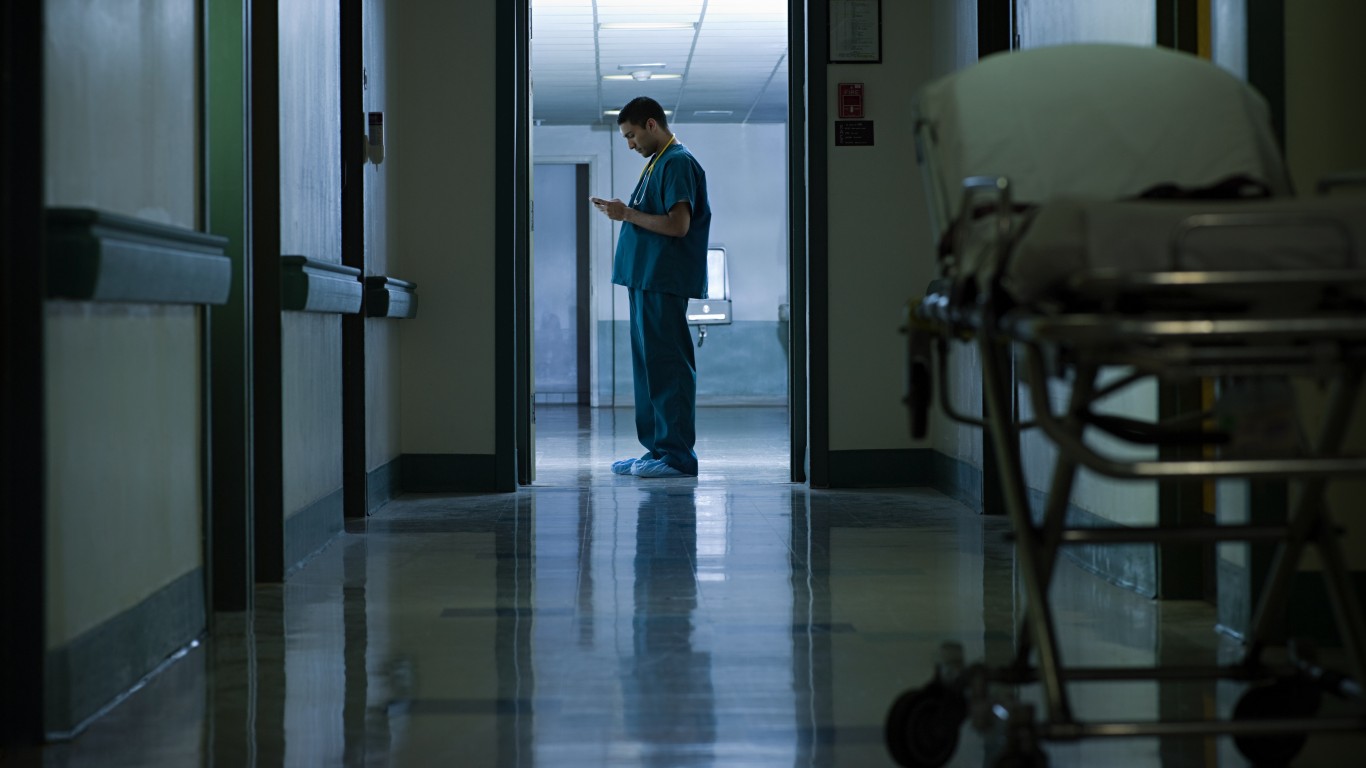
Deaths in the U.S. have skyrocketed over the last several years. While the U.S. population rose just 1.4% from 2018 to 2021, the number of deaths rose 22.0% – the largest increase in mortality in 100 years. Life expectancy fell from 78.8 years in 2019 to 76.1 years in 2021, reversing decades of steady progress in longevity. These are the 15 leading causes of death in America.
While the rapid increase in excess mortality is largely due to COVID-19, directly or indirectly, there are smaller, stealthier, pandemics killing Americans at alarming rates. And while many leading causes of death have spiked due to indirect or direct collateral damage from the coronavirus, several of the main culprits contributing to rising morbidity have been decades in the making.
To determine the fastest growing causes of death, 24/7 Tempo reviewed data on mortality rate for 113 selected causes of death from the Centers for Disease Control and Prevention. Major causes of death were ranked based on the change in crude mortality rate – annual deaths per 100,000 Americans – from 2018 to 2021.
Hospitals were overburdened during the COVID-19 pandemic, and posed risks of their own to patients looking to avoid contracting the virus. According to one CDC estimate, by July 2020 41% of U.S. adults had delayed or avoided medical care due to concerns about COVID-19. As a result, patients with life-threatening conditions like heart attack or stroke may have forgone necessary treatment, increasing overall morbidity for non-COVID disease. So while the coronavirus caused the largest shock to U.S. mortality, deaths due to cardiovascular disease also skyrocketed, with over 62,000 more Americans dying of heart disease in 2021 than in 2018.
Click here to see the fastest growing causes of death in America
Lockdowns and social distancing during the COVID-19 may also be associated with increasing mortality among several causes of death. More than one in seven Americans, for example, rely on food banks and pantries in some capacity. As COVID-19 lockdowns cut off access to critical food assistance networks, malnutrition claimed a record number of American lives, and became one of the fastest growing causes of death.
Similarly, reduced access to care as well as isolation may have contributed to the excess mortality of two concurring pandemics – the opioid crisis and alcoholism, which cause so-called “deaths of despair.” According to the National Institute on Alcohol Abuse and Alcoholism, sales of alcohol increased by 2.9% in 2020, the largest one-year increase in over 50 years. Deaths due to alcoholic liver disease rose 40.8% from 2018 to 2021 as drug overdose deaths rose 56.1% – together accounting for an increase of nearly 50,000 additional deaths. (These are 25 famous people who drank themselves to death.)

10. Parkinson’s disease
> Change in mortality rate, 2018 to 2021: +1.3 deaths per 100,000 Americans
> Mortality rate, 2021: 11.6 deaths per 100,000 Americans
> Mortality rate, 2018: 10.3 deaths per 100,000 Americans
> Total deaths, 2021: 38,536
> Total deaths, 2018: 33,829
Parkinson’s disease is a chronic, progressive movement disorder that, while not itself fatal, can increase the likelihood of premature death, particularly from aspiration pneumonia.The Parkinson’s disease death rate has risen steadily over the past several years, from 10.3 deaths per 100,000 Americans in 2018 to 13.5 deaths per 100,000 in 2021 – amounting to nearly 5,000 additional deaths. While more Parkinson’s cases are likely to occur in an aging population, the death rate from the disease is rising significantly even when adjusted for age. The reasons for the rise in the Parkinson’s mortality rate are unclear, some excess deaths may be due to the disruption of health care services caused by the COVID-19 pandemic.
[in-text-ad]

9. Falls
> Change in mortality rate, 2018 to 2021: +2.0 deaths per 100,000 Americans
> Mortality rate, 2021: 13.5 deaths per 100,000 Americans
> Mortality rate, 2018: 11.4 deaths per 100,000 Americans
> Total deaths, 2021: 44,686
> Total deaths, 2018: 37,455
Over the past several years, the mortality rate from accidental falls rose from 11.4 deaths per 100,000 Americans in 2018 to 13.5 deaths per 100,000 Americans in 2021 — an increase in more than 7,000 additional deaths. The rise in fall deaths is part of a decade-long trend, as the population ages and becomes at higher risk for fall incidents. But while elderly Americans constitute a bulk of fall deaths, fall deaths have also increased for Americans younger than 65 over the past several years.

8. Homicide
> Change in mortality rate, 2018 to 2021: +2.1 deaths per 100,000 Americans
> Mortality rate, 2021: 7.8 deaths per 100,000 Americans
> Mortality rate, 2018: 5.8 deaths per 100,000 Americans
> Total deaths, 2021: 26,031
> Total deaths, 2018: 18,830
While the COVID-19 pandemic corresponded with reductions in crimes like robbery and larceny, the homicide rate rose sharply in both urban and rural areas. The homicide mortality rate rose from 5.8 homicide deaths per 100,000 Americans in 2018 to 7.8 per 100,000 in 2021 — accounting for more than 7,000 additional deaths. While it is still too early to assess long-term trends in homicide since the pandemic, some criminologists attribute the rise in murder to increased social friction, reduced access to social services, and a proliferation of gun carrying in public spaces.

7. Motor vehicle accidents
> Change in mortality rate, 2018 to 2021: +2.1 deaths per 100,000 Americans
> Mortality rate, 2021: 14.2 deaths per 100,000 Americans
> Mortality rate, 2018: 12.0 deaths per 100,000 Americans
> Total deaths, 2021: 46,980
> Total deaths, 2018: 39,404
While the decline in motor vehicle fatalities since the 1970s has been one of the great public health achievements of the last 50 years, the number of Americans dying from car crashes has recently risen sharply. Even as traffic volume declined during the COVID-19 pandemic, the motor vehicle accident mortality rate rose from 12.0 deaths per 100,000 American in 2018 to 14.2 per 100,000 in 2021. That means more than 7,500 additional deaths. According to data from the U.S. National Highway Traffic Safety Administration, deaths due to motor vehicle collisions have risen fastest amongst the most vulnerable on the road – motorcyclists, cyclists, and pedestrians.
[in-text-ad-2]

6. Malnutrition
> Change in mortality rate, 2018 to 2021: +2.3 deaths per 100,000 Americans
> Mortality rate, 2021: 5.2 deaths per 100,000 Americans
> Mortality rate, 2018: 2.9 deaths per 100,000 Americans
> Total deaths, 2021: 17,106
> Total deaths, 2018: 9,335
Every year, more than 50 million Americans – approximately one in seven U.S. residents – receive help from food banks and food pantries. As COVID-19 lockdowns cut off access to critical food assistance networks, a record number of U.S. adults died from malnutrition in 2021 – some 17,106 in all, most of them elderly. This represents a stunning 83.2% increase over 2018.

5. Alcoholic liver disease
> Change in mortality rate, 2018 to 2021: +2.9 deaths per 100,000 Americans
> Mortality rate, 2021: 10.0 deaths per 100,000 Americans
> Mortality rate, 2018: 7.1 deaths per 100,000 Americans
> Total deaths, 2021: 33,098
> Total deaths, 2018: 23,172
While alcohol deaths have increased steadily over the past two decades, they spiked dramatically during the pandemic. Among the major risk factors for alcohol abuse are stress, anxiety, and loneliness – all of which increased in the peak COVID-19 period. According to the National Institute on Alcohol Abuse and Alcoholism, sales of alcohol increased by 2.9% in 2020, the largest one-year increase in over 50 years. Excessive alcohol use takes a heavy toll on the liver, and can result in fatal cases of cirrhosis and other liver diseases. The alcohol liver disease mortality rate rose from 7.1 deaths per 100,000 Americans in 2018 to 10.0 deaths per 100,000 in 2021, representing an increase of nearly 10,000 additional deaths.
[in-text-ad]

4. Diabetes mellitus
> Change in mortality rate, 2018 to 2021: +5.2 deaths per 100,000 Americans
> Mortality rate, 2021: 31.1 deaths per 100,000 Americans
> Mortality rate, 2018: 26.0 deaths per 100,000 Americans
> Total deaths, 2021: 103,294
> Total deaths, 2018: 84,946
The diabetes mortality rose precipitously after the onset of COVID-19, from 26.0 deaths per 100,000 Americans in 2018 to 31.1 deaths per 100,000 in 2021 — meaning more than 18,000 additional deaths. Deaths from the disease surpassed 100,000 for the first time in American history in 2020, and continue to rise. While diabetes mellitus is a manageable disease, the high cost of medications like insulin and inadequate access to medical care lead many diabetes patients to forgo vital treatment – a situation that was only worsened by an overburdened healthcare system during the pandemic.

3. Drug overdose
> Change in mortality rate, 2018 to 2021: +11.6 deaths per 100,000 Americans
> Mortality rate, 2021: 32.1 deaths per 100,000 Americans
> Mortality rate, 2018: 20.6 deaths per 100,000 Americans
> Total deaths, 2021: 106,699
> Total deaths, 2018: 67,367
Led by a rise in opioid deaths, the drug overdose mortality rate rose from 20.6 deaths per 100,000 Americans in 2018 to 32.1 deaths per 100,000 in 2021 — representing an additional 39,000 deaths. The opioid overdose epidemic started in the late 1990s, when doctors began to prescribe opioids for minor injuries and ailments at increasing rates. Hooked on highly addictive medication – as many as one in four patients receiving long-term opioid therapy struggle with addiction – many pain patients turn to illegal sources of opioids like heroin or the far more potent fentanyl, often times not knowing whether they are getting one or the other. Suffering from an all-consuming addiction and a lack of access to medical care, Americans continue to die deaths of despair at rising rates.

2. Major cardiovascular disease
> Change in mortality rate, 2018 to 2021: +14.9 deaths per 100,000 Americans
> Mortality rate, 2021: 279.0 deaths per 100,000 Americans
> Mortality rate, 2018: 264.0 deaths per 100,000 Americans
> Total deaths, 2021: 925,923
> Total deaths, 2018: 863,834
The mortality rate from major cardiovascular deaths rose from 264.0 deaths per 100,000 Americans in 2018 to 279.0 deaths in 2021, more than any major cause of death other than COVID-19. While the rate of deaths due to major cardiovascular disease may increase naturally in an aging population, the spike in heart disease deaths is likely both a direct and indirect result of the pandemic. New research, for example, has shed light on the direct negative impacts of the coronavirus on cardiovascular health, such as increased clotting and inflammation. The pandemic also likely led to increased mortality for non-COVID conditions in general, as hospitals reached capacity and patients with existing heart disease and stroke symptoms received delayed medical care, or none at all.
[in-text-ad-2]

1. COVID-19
> Change in mortality rate, 2018 to 2021: +125.6 deaths per 100,000 Americans
> Mortality rate, 2021: 125.6 deaths per 100,000 Americans
> Mortality rate, 2018: 0.0 deaths per 100,000 Americans
> Total deaths, 2021: 416,893
> Total deaths, 2018: 0
On January 20, 2020, the CDC reported the first laboratory-confirmed case of COVID-19 in the U.S. A second case was confirmed several days later, and by the end of the month, the CDC had issued a 14-day quarantine for all those returning to the country from Wuhan, China. COVID-19 cases and deaths rose precipitously from there, with deaths peaking in the winter of 2021 and surpassing the 1918 flu as the deadliest pandemic in American history. In 2021 alone, 417,000 Americans died from COVID-19, more than any major cause of death besides heart disease and cancer. COVID-19 deaths contributed to 74% of the decline in U.S. life expectancy from 78.8 years in 2019 to 77.0 years in 2020, and 50% of the decline to 76.1 years in 2021.
Take Charge of Your Retirement In Just A Few Minutes (Sponsor)
Retirement planning doesn’t have to feel overwhelming. The key is finding expert guidance—and SmartAsset’s simple quiz makes it easier than ever for you to connect with a vetted financial advisor.
Here’s how it works:
- Answer a Few Simple Questions. Tell us a bit about your goals and preferences—it only takes a few minutes!
- Get Matched with Vetted Advisors Our smart tool matches you with up to three pre-screened, vetted advisors who serve your area and are held to a fiduciary standard to act in your best interests. Click here to begin
- Choose Your Fit Review their profiles, schedule an introductory call (or meet in person), and select the advisor who feel is right for you.
Why wait? Start building the retirement you’ve always dreamed of. Click here to get started today!
Thank you for reading! Have some feedback for us?
Contact the 24/7 Wall St. editorial team.
 24/7 Wall St.
24/7 Wall St.


